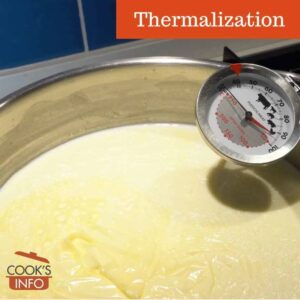Pasteurization is a heat-treatment process designed to inactivate bacteria.
It is not as thorough as sterilization: it is not intended to kill all micro-organisms, just to greatly reduce the number of ones that could cause illness and disease. It also extends the refrigerated shelf life of products.
Pasteurization is a function of both temperature and time.
“Vat pasteurization” brings the milk to 63ºC (145ºF) for 30 minutes. [1]Pasteurization. International Dairy Foods Association. Accessed September 2022 at https://www.idfa.org/pasteurization .
A pasteurization method known as “High Temperature Short Time” (72 °C × 15 seconds) is designed to kill 99.999% of the number of the micro-organisms in fluid milk in 15 seconds. (Note it doesn’t remove the microbes; it just inactivates them.)
Pasteurization processes are usually legally defined in country or in a jurisdiction, by laws governing food.
There are two main pasteurization techniques:
- High Temperature/Short Time (HTST)
- Ultra High Temperature (UHT)
There is also a third process, Thermalization, which many government health departments don’t recognize as pasteurization for legal purposes.
Pasteurization is typically applied to dairy, fruit juices, and (in North America) apple cider. Since September 2007, all almonds produced in California have to be pasteurized.
There is now also a technique for pasteurizing whole, shell eggs. See the entry on Pasteurized Eggs.
Unpasteurized milk is referred to as raw milk.
See also: Listeria, Anniversary of First Pasteurisation Test
History Notes
The pasteurization process was discovered by French scientist Louis Pasteur. At the time, he was investigating why wine and beer spoiled. He was working with Claude Bernard. Their first test was on 20 April 1862.
Further reading
Pasteurization time / temperature tables.
Sources
University of Guelph. Dairy Science and Technology Department. Pasteurization. Retrieved September 2010 from http://www.foodsci.uoguelph.ca/dairyedu/pasteurization.html.
Related techniques
HTST Pasteurization
Micro-Filtered Milk
Thermalize
UHT Pasteurization
References
| ↑1 | Pasteurization. International Dairy Foods Association. Accessed September 2022 at https://www.idfa.org/pasteurization |
|---|


